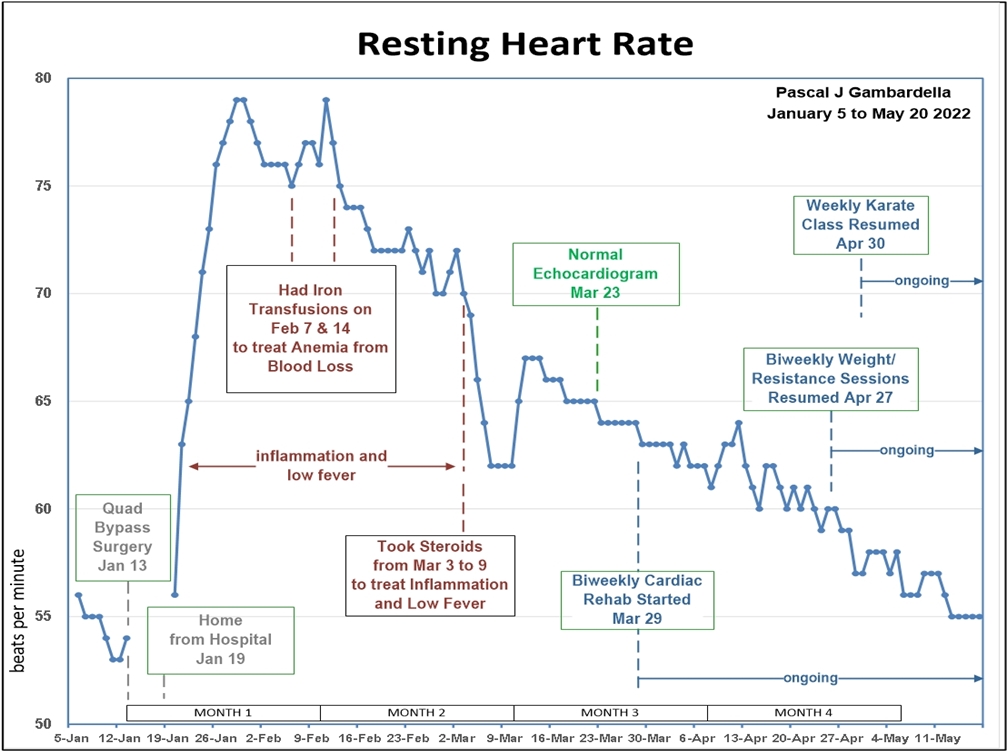
On January 13, 2022, I underwent coronary artery bypass surgery. Afterward, I was groggy with three long draining-tubes below my rib cage. My chest hurt since the surgeon had to break bones to get to my heart. I needed to hug a heart-shaped pillow to protect my chest when I moved, coughed, or laughed.
On the bright side, the surgeon did not put me on a heart-lung machine. He would have had to stop my heart. Instead, he operated while my heart was beating, which meant recovery would be faster.
Crisis of the Heart
This is the second in a series of articles on my crisis of the heart. The first article, Surviving a Crisis of the Heart, discussed how I prepared for surgery. Both articles cover my four-part resilience strategy for managing the crisis. My first article covered the first three parts: (1) Having a Compelling Future, (2) Accepting the Crisis, and (3) Accessing Inner Resources. This article adds to part (3) by discussing a social panorama technique for accessing resources. Then it covers the last part, (4) Having an Optimistic Explanatory Style.
Accessing Inner Resources
While immobile in a hospital bed, I did an exercise that relies on our social panorama. It is the internal landscape we can use to represent people in our lives. Lucas Derks pioneered it as an NLP therapeutic approach to handle issues with people. In contrast, I created the exercise to gain support from people while powering up on resources. Rather than seek a resource for a specific problem, I was gathering them for unknown ones.
Powering-Up within Our Social Panorama

Photo by Robert Lukeman on Unsplash
The exercise is about remembering resources you have, so they are at your fingertips when needed. When people are furious, their world closes in, their access to useful resources diminishes, and they become less flexible. This can happen in any crisis and we need to remember our resources to better handle it. Here is the exercise.
Start with a personal crisis. Looking through your own eyes, imagine you meet with several groups of people, one group at a time. Each weaves an important thread through your life. You associate each group with resources you gained, or were nurturing, while with them.
Rely on your unconscious mind to select the groups and choose the resources. Bring each new group to the foreground, one at a time, allowing the earlier group to fade. Then, keep rotating the groups while acquiring support and accumulating resources.
My Experience
I started with my family and felt their support with big hugs. Other groups were Neuro-Semantics and the Martial Arts. Each group included my mentors, friends, and students. The next two sections give examples from the Martial Arts group.
Inner Resource: Knowing When to Move
Years ago, in my martial arts studio, we started teaching simple self-defense approaches. Now, these approaches helped my recovery.
For example, during the middle of my first night at the hospital, an x-ray tech came to take my daily chest image. Lying in bed with broken chest bones, I could not move much. He quickly shoved an x-ray cassette behind my back and I yelled in intense pain. My ribs hurt when my waist bent. I don’t think he understood my injury. Later, I thought about how I could use my self-defense resources to protect myself.

Kevin Grieve on Unsplash
Being in a state of situational awareness is a self-defense resource. For example, when in this state and walking down a crowded street, you pay attention to your surroundings and not to your mobile phone. If a sudden disruption occurs, you can quickly assess the situation and respond as needed. It is a state of calm alertness.
The same x-ray tech came in the next night. I awoke at once and assessed the situation. I pulled my heart-shaped pillow to my chest, pointed to him and said, “wait.” Then I explained how to help me gently bend forward so he could position the cassette.
Inner Resource: Exploring How to Move

Photo by Aziz Acharki on Unsplash
The other self-defense resource is about being body-aware and exploring physiology. For example, imagine your back is against a wall and a man is choking you with both hands. What can you do?
Take your hands with palms up and place them under his elbows and exert a light pressure up. While you are doing this, he cannot choke you and he wonders why. This gives you a chance to escape, usually by bringing your knee up to his groin with an ear-shattering yell. Here, physical awareness and knowledge of physiology helps get to a safe place.
I used this skill, exploring how to move, to get out of bed after returning home from the hospital. How do you get out of bed while lying on your back when you can’t bend at the waist? Before surgery, to get out of bed, I would hang my legs over the side of the bed, bend at my waist, sit up and stand. This was no longer pain-free.
With some experimentation, I found a new way: I pulled my heart pillow to my chest, then slid my feet toward my bottom while raising my knees. I slowly rotated my body to my right side and let my feet hang over the edge of the bed a bit. Next, with my right elbow on the bed, I placed my left hand on my right fist and pushed down with my left hand while dropping my feet to the ground and sitting up. From there, I could stand. Exploring how to move allowed me to gain more control over the outcome and protect myself from pain.
Having an Optimistic Explanatory Style
How do you explain negative events? A pessimistic style explains these events using the cognitive distortions: pervasive (undermines everything), permanent (lasts forever), and personal (all about the self) (Seligman, 2006). A pessimist expects the worst.

Addressing these distortions supports an optimistic explanatory style, which helps expect the best. In their paper on coronary artery bypass surgery, Schier et al. (1999) concluded optimism predicted a lower rate of rehospitalization after the surgery. They said “fostering positive expectations may promote better recovery.”
How can an optimistic explanatory style support recovery? It is not about denying the seriousness of the issue, but about being aware of your options and resources. That awareness supports resilience.
Addressing the Distortions
I addressed the pessimist-style distortions by being aware of them, accessing a state of optimism, and then asking myself three questions: Is this pervasive? Is this permanent? Is this personal?
I knew my crisis was not pervasive since it pertained to a medical crisis, a limited part of my life. It was not entirely personal, since I believed genetics was a powerful factor in my illness. Also, I did not blame myself for the crisis. It was not permanent since, for example, plotting a graph of my resting heart rate each day and seeing steady improvement helped confirm the crisis was temporary.
Being Resilient

Photo by Mark Harpur on Unsplash
Being resilient helped with two major obstacles after surgery. Because of my blood loss, I did not have enough iron to make enough red blood cells. This led to fatigue and loss of appetite. So, I had two transfusions of iron. I had a low-grade fever that lasted for months. Once the doctor confirmed internal inflammation as its cause, I took steroids to treat it.
Beyond the medical interventions, an important treatment for both issues was resilience. It was essential to my full recovery.
References and Resources
Derks, Lucas. Social Panoramas: Changing the Unconscious Landscape with NLP and Psychotherapy. 2005. Norwalk: Crown House Publishing Company, Ltd.
Hall, L. Michael. Resilience: Being the Phoenix, 2020. Clifton: Neuro-Semantic Publications.
Gambardella, Pascal. Cognitive Distortions Concept Map. 2017.
Gambardella, Pascal. Side-Stepping Violence, 2020. My insights as a martial artist.
Gambardella, Pascal. Surviving a Crisis of the Heart. 2022. This is the first in a series of articles on managing a major health crisis.
Hall, L. Michael. Sourcebook of Magic, Vol. II, 2004. Clifton: Neuro-Semantic Publications. See the two patterns on the social panorama: Accessing the Social Panorama (p 249), Meta-Stating Your Social Panorama (p. 230)
Moore, Catherine. Learned Optimism: Is Martin Seligman’s Glass Half Full? 2019.
Seligman, M. E. P. 2006. Learned optimism: How to change your mind and your life. Vintage.
Scheier MF, Matthews KA, Owens JF, Schulz R, Bridges MW, Magovern GJ, Carver CS. Optimism and rehospitalization after coronary artery bypass graft surgery. Arch Intern Med. 1999 Apr 26; 159 (8):829-35.
Acknowledgments
Thanks to my brilliant editors, Claire Kurs and Daniel Gambardella. Thanks to Izette Fry for suggesting the name “powering-up” for my social panorama exercise.
Clif Brown taught us the response to being choked. I appreciate him, Heidi Schweingruber, and Mark Shappirio for our ongoing self-defense discussions.
I am grateful to all the mental professionals who helped me after my surgery, including: Dr, Jose Quiros (primary care), Dr. Fayyaz Hashmi (surgery), Dr. Victor Priego (hematology), Rosa (visiting nurse), and Dr. Harry Bigham (cardiology).
Daniel Gambardella took my photo, which appears at the beginning of this article.
Views: 96

 Pascal is a master modeler, who has modeled physical phenomena, satellite motion, and the behavior of people, organizations, and corporations.
Pascal is a master modeler, who has modeled physical phenomena, satellite motion, and the behavior of people, organizations, and corporations.
Thanks for sharing this, Pascal. I will think about how I can apply some of this in my daily life, too. Especially when I get pessimistic.
You are truly inspirational! We would have vastly better world if even ten percent of people were as rational and non-judgemental as you.
Thanks for sharing!
Thanks for reading!